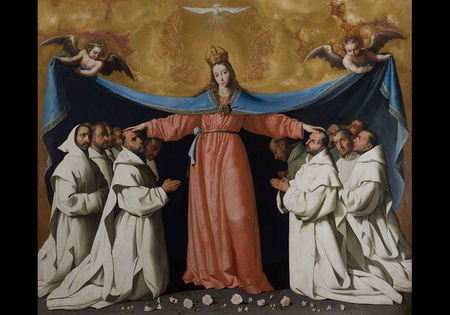'The Sacred Made Real: Spanish Painting and Sculpture 1600-1700' @ National Gallery
Diego Velázquez (1599–1660), Portrait of Juan Martínez Montañés, 1635 © Museo Nacional del Prado, Madrid
LONDON.- Created to shock the senses and stir the soul… 'The Sacred Made Real' presents a landmark reappraisal of religious art from the Spanish Golden Age. Paintings including masterpieces by Diego Velázquez and Francisco de Zurbarán are displayed for the very first time alongside Spain’s remarkable ‘polychrome’ (painted) sculptures.
While the religious paintings of Velázquez and Zurbarán are relatively well known, the polychrome sculptures which also emerged from 17th-century Spain have never been the subjects of a major exhibition. Still passionately venerated in monasteries, churches and processions across the Iberian Peninsula, very few of these sculptures have ever been exhibited overseas.
During the Spanish Counter-Reformation, religious patrons, particularly the Dominican, Carthusian and Franciscan orders, challenged painters and sculptors to bring the sacred to life, to inspire both Christian devotion and the emulation of the saints. The exhibition brings together some of the finest depictions of key Christian themes including the Passion of Christ, the Immaculate Conception and the portrayal of saints, notably Pedro de Mena’s austere rendition of Saint Francis Standing in Meditation, 1663, which has never before left the sacristy of Toledo Cathedral.
By installing 16 polychrome sculptures and 16 paintings side-by-side, the exhibition aims to show that the ‘hyperrealistic’ approach of painters such as Velázquez and Zurbarán was clearly informed by their familiarity – and in some cases direct involvement – with sculpture.
Last seen in Europe over 50 years ago and a crucial loan to the exhibition, Zurbarán’s masterpiece, 'The Crucifixion', 1627 (Art Institute of Chicago) achieves an astonishing sculptural illusion on canvas. When seen in close proximity with Juan Martínez Montañés’ polychrome sculpture of 1617 (Church of the Convent of Santo Ángel, Seville), these two art forms begin an intense natural dialogue.
In Seville, Francisco Pacheco taught Velázquez, later his son-in-law, and a generation of artists the skill of painting sculpture as an integral element of their training. Pacheco himself painted the flesh tones and drapery of exquisite wooden sculptures carved by fellow Andalucian, Montañés, known by his contemporaries as ‘the god of wood’. Among the most important examples is their life-size 'Saint Francis Borgia Meditating on a Skull', 1624 (Church of the Anunciación, Seville University) commissioned by the Jesuits to celebrate his beatification that year. Another highlight of the exhibition is the fascinating juxtaposition of Velázquez’s 'The Immaculate Conception', 1618–19 (National Gallery, London) with Montañés’s exquisite polychrome sculpture of the same subject, about 1620 (Seville University).
To obtain even greater realism, some sculptors such as Pedro de Mena and Gregorio Fernández introduced glass eyes and tears as well as ivory teeth into their sculptures. Fernández’s astonishingly realistic 'Dead Christ', 1625–30 (Museo Nacional del Prado, Madrid; on long term loan to the Museo Nacional Colegio de San Gregorio, Valladolid) incorporates the bark of a cork tree to simulate the effect of coagulated blood, and bull’s horn for Christ’s fingernails. It was fully intended that believers should feel truly in the presence of the dead Christ.
During 'Semana Santa' (‘Holy Week’), some 17th-century polychrome sculptures are still carried through the streets by religious confraternities, particularly in Seville, Granada and Valladolid, the most important centres of this art. During the evening of Palm Sunday, Seville’s Archicofradía del Cristo del Amor (‘Confraternity of the Christ of Love’) process a life-size sculpture of the Crucifixion by Juan de Mesa. The exhibition features a smaller version of this work, about 1621, which although non-processional, plays a vital role in the pastoral life of the confraternity.
While sometimes deeply unsettling, depictions of Christ’s suffering or indeed Juan de Mesa’s 'Decapitated Head of Saint John the Baptist', about 1620 (Seville Cathedral) are also exquisitely finished. When depicting the saints, sculptors and polychromers combined their skills to achieve maximum facial expressiveness. Alonso Cano’s life-size head of Saint John of God, 1655 (Museo de Bellas Artes, Granada), which has never left Spain before, depicts with astonishing sensitivity the compassionate expression of Granada’s patron saint.
Zurbarán’s heightened illusionism, in particular his handling of fabric, shows an acute understanding and appreciation of sculpture. Once in British collections and now returning to the UK for the first time in over 50 years, 'Saint Serapion', 1628 (Wadsworth Atheneum Museum of Art, Hartford, CT), is among the artist’s greatest achievements. The saint’s voluminous white habit cascades with astonishingly rendered crevasses of deep shadow. Here, Zurbarán demonstrates that painting can indeed achieve the same disconcerting realism as sculpture.
The religious art of 17th-century Spain pursued a quest for realism with uncompromising zeal and genius. Far from being separate, this exhibition proposes that the arts of painting and sculpture were intricately linked and interdependent.
Francisco de Zurbarán (1598–1664), Virgin of the Misericordia, 1634 © Photo Imagen M.A.S. Courtesy of Museo de Bellas Artes, Seville

/https%3A%2F%2Fprofilepics.canalblog.com%2Fprofilepics%2F1%2F0%2F100183.jpg)
/https%3A%2F%2Fstorage.canalblog.com%2F03%2F02%2F119589%2F96711876_o.jpg)
/https%3A%2F%2Fstorage.canalblog.com%2F11%2F31%2F119589%2F94773502_o.jpg)
/https%3A%2F%2Fstorage.canalblog.com%2F20%2F83%2F119589%2F94772815_o.jpg)
/https%3A%2F%2Fstorage.canalblog.com%2F26%2F72%2F119589%2F75604929_o.jpg)
/https%3A%2F%2Fstorage.canalblog.com%2F59%2F60%2F119589%2F26458628_o.jpg)




/http%3A%2F%2Fstorage.canalblog.com%2F54%2F46%2F119589%2F119205652_o.jpg)
/http%3A%2F%2Fstorage.canalblog.com%2F98%2F13%2F119589%2F112775955_o.jpg)
/http%3A%2F%2Fstorage.canalblog.com%2F22%2F02%2F119589%2F111454616_o.jpg)
/http%3A%2F%2Fstorage.canalblog.com%2F65%2F28%2F119589%2F69576540_o.jpg)